Cerro Torre - South east ridge
13. Filo Sureste (SE ridge)
800m 7a C2 WI5, 7c (with variations)
Hayden Kennedy (USA) and Jason Kruk (Canada), 1/2012.
Description. A historic line that follows the natural features up the SE ridge. It was 44 years in the making. The crux is the last 70 vertical meters, right before the summit plateau.
The first ten pitches climb cracks on the ridge and just right of the ridge with difficulties to 6b. After that the climbing gets harder. A steep rock step involves a tricky thin crack (20m C1) that has two “retro bolts” at its start. Note that this crack can at times be covered by a rime mushroom, but one can either dig through it or avoid it by climbing immediately left (A2 or 7c). The following pitch (40m) climbs a series of discontinuous features up a slab to reach a blank arête with mandatory free climbing to 6a+ (two “retro bolts” in the pitch and two more “retro bolts” in the belay). The following pitch is up a mostly blank arête (6b, three bolts). From that point easy climbing leads to and through the ice towers (3 pitches to 80º). Below a blank rock pillar with one of Maestri's massive bolt-ladders, traverse left, west, to an obvious ice chimney (50m WI5) and the base of the headwall.
The first headwall pitch is 6a and is relatively short (50m). The second, 60-m pitch, involves free-climbing (6c) up flakes and thin cracks, with protection that is always adequate, but at times sparse. The quality of the rock here is marginal. There is some concern about the stability of this entire pitch, it is a flake, a huge flake, and a similar sized one fell off on the right side of the headwall in 2016. At an obvious left leaning ledge/ramp there are two options, head up and left to the original line or up and right for the free line. Time will tell which of these options becomes the preferred line.
The original line climbs left to a single bolt to make a big pendulum to a natural belay (three good camalot placements) on the south edge of the headwall. The next pitches are short, climbing up flakes and discontinuous cracks involving free climbing to 7a and some aid (C2, some hooking). This section can often be covered by rime. There is no fixed gear in this section except for a single fixed piton.
The free line (7a/+) climbs up then slightly right to reach a belay (two good camalots) just right and level with Maestri's abandoned compressor. From here climb up (5m) to two good camalot placements, then right on small edges and holes (10m) to another camalot placement, to hit a system that leads to the top of the headwall, traversing back left to belay at the end of the Compressor Route. The second ascent party noted that the last pitches can be protected "without much problem".
In the headwall this route and its free variation use four bolt anchors belonging to the now defunct Compressor Route. Three of those anchors are original, dating to 1970.
There are a few bits of old rope on the first pitches, especially the third and fourth. This is mostly due to hanged rappels. Make short rappels in that section to avoid the same fate.
History. The natural line up the SE ridge was first attempted in early 1968 by an Anglo-Argentine team including Martin Boysen, Mick Burke, Pete Crew, Jose Luis Fonrouge and Dougal Haston. They reached a point 450 meters above the Col de la Paciencia (which they christened), having climbed 13 pitches. About this attempt, Dougal Haston wrote “Defeat is rarely pleasant. Sometimes it affords relief, but the relief is always temporary, suddenly eclipsed by the realization that you have failed. Self-analysis follows: you have turned back. Was the decision justifiable or was it made in a moment of hopelessness, when despair made the problems seem insuperable? The object of going onto a mountain is to climb it; to reach the end of your chosen route. It is very simple but many forget this. The story of Cerro Torre is the story of a defeat. We judge that we made the right decision, but we might be trying to cover personal defects. The rights and wrongs, and our bitterness, were scattered by the Patagonian winds.”
In 1999 Italians Mauro Mabboni and Ermanno Salvaterra added two pitches above the 1968 highpoint to reach the easy ground at the base of the ice towers, continuing up via the Compressor route. During this attempt Mabboni and Salvaterra added two retro-bolts at the base of the thin crack, two retro-bolts in the last pitch climbed in 1968, and two more in that belay. In the following pitch, which they opened, they placed three more bolts.
In 2007 Americans Zach Smith and Josh Wharton followed Mabboni and Salvaterra’s footsteps but at the base of Maestri’s ice towers bolt ladder they climbed left, into a beautiful 60-meter ice-covered chimney that is 1 meter wide (WI5). Via that chimney they reached the base of the headwall, climbing the first headwall pitch before also joining the Compressor (clipping Maestri’s bolts). Smith and Wharton found the thin overhanging crack (pitch 11) covered by a snow mushroom so they climbed left, onto the south side, up other thin cracks making a tension traverse to rejoin the thin crack above the mushroom (6c/A2 or 8a).
After their attempt to climb the natural line up the SE ridge Wharton and Smith attempted to chop one of Maestri’s bolts to see if it would be possible to return CT to a more natural state. This failed attempt to chop a single bolt generated a strong reaction from some climbers who think the bolts should stay. The ordeal included a scuffle, a visit to the hospital, another one to the police –to cry in a policeman’s shoulder...-, some vandalism, many articles in climbing magazines, a vote at a public gathering in which 99% of the people voting had never touched CT, etc.
In February of 2011 Canadians Chris Geisler and Jason Kruk reached a point 40 meters below the top of the headwall climbing along the SE ridge’s natural line (without using any of Maestri's bolts for progression). They followed the Mabboni-Salvaterra and Smith-Wharton lines to the headwall, climbing two more pitches up the headwall to reach an obvious ledge one pitch below the compressor. From here they traversed left and after placing a bolt traversed back right to reach a point level with the compressor but about 10 meters left of it. In the early morning, after having climbed through the night and in very high winds Geisler lowered and they retreated.
In January of 2012 Kennedy and Kruk climbed to 10 meters below Geisler and Kruk’s high point and at the bolt continued left, making a big pendulum that led to a series of discontinuous systems and the top. They took a mere 13 hours to complete this impressive ascent, short-fixing most of the way up.
During their descent Kennedy and Kruk chopped 120 of Maestri’s bolts, including most of the headwall and part of the big traverse.
First Free Ascent. Five days after Kennedy and Kruk’s impressive ascent Austrian David Lama belayed by Peter Ortner completed the first free ascent of the SE ridge. At the thin steep crack Lama climbed a line similar to Wharton’s, managing to redpoint it after a couple of attempts (rated originally 8a, now 7c). In the headwall Lama and Ortner followed the Kennedy-Kruk line to where this heads left, making a two pitch variation just right of where the Maestri’s bolts used to be (rated originally 7b, now 7a/+). The fact that it was carried out after the bolt removal, freeclimbing the headwall on natural gear, made it all the more impressive. However, Lama and Ortner were not alone in the climb. A helicopter flew overhead, filming the pair for most of the ascent and a cameraman and two mountain guides were at the summit documenting the climb. Although Lama and Ortner carried their own gear and did not receive any explicit assistance, the possibility of a quick rescue and evacuation in the event of an accident drastically reduced the commitment level and seriousness of their climb. Both physically and psychologically this ascent was vastly different from ascents carried out by entirely self–reliant climbing teams.
At the 2013 Piolets d'Or event Kennedy, Kruk, Lama and Ortner were awarded "special mentions" for their ascents. The Jury was composed by Stephen Venables, Silvo Karo, Gerlinde Kaltenbrunner and Jumbo Yokoyama. The press release, which expresses unequivocal support for the de-bolting, can be read here.
Other ascents. In January 2013 Luka Krajnc and Tadej Krišelj (SI) did the third ascent of the Filo Sureste by fair-means, following the Kennedy- Kruk line and climbing the last two pitches via the Lama-Ortner variation. The same line was followed by the three parties that repeated the route in early 2016: Matteo Della Bordella and Silvan Schupbach; Christian Ledergerber, Friedrich Madere, Roger Schaeli and Tobias Sutter; Gabriel Fava and Martin Lopez Abad. The seventh and eigth ascents were done in early 2019 by Leo Billon, Max Bonniot and Pierre Llabre (FR) and Ondrej Huserka and Jozef Kristoffy (SK). In trying to free the lower Lama variation, the Slovak climbers broke a key hold and took a fall that ripped two in-situ pitons. If you are keen to repeat this free variation, take a couple of Peckers to replace the missing ones.
Second free ascent. In early 2016, Andrew Rothner, Mikey Schaefer and Josh Wharton did the second free ascent. Andrew lead the crux on his second go, while Josh followed it first try, and Mikey also followed it free on his second try. They thought the cruck pitch is 7c, and the last two pitches in the 7a/+ range.
Approach. Niponino to Noruegos to Glaciar Torre Superior, then up to the Col de la Paciencia (400m 65˚ 4+).
Descent. Two rappels along the Compressor Route line, then follow the ascent line.
Bibliography. Boysen et al: AJ 1968 p. 186-198; Mountain Craft magazine 81 p. 26-32; Haston D. (1972) In High Places, Cassell & Company, London (p. 96-106). |
Photos (click to enlarge)
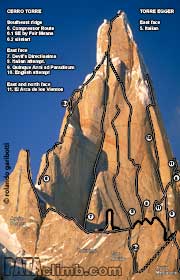
Cerro Torre southeast face 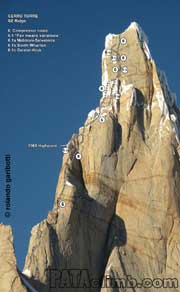
Cerro Torre southeast face 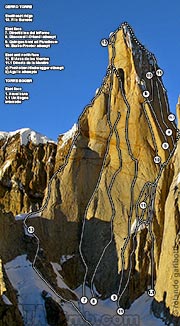
Cerro Torre east face
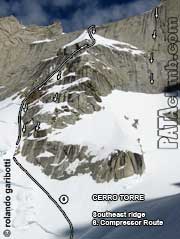
Cerro Torre southeast face 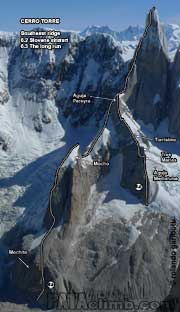
Cerro Torre east face
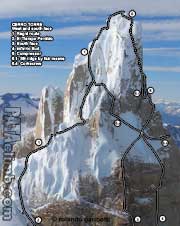
Cerro Torre southwest face
|
13.3 The Corkscrew link-up
1200m (ca. 200 new) 90˚ 6b A1
Ole Lied and Trym Atle Saeland (NO) 2/12/2008 (using some Compressor route bolts). Colin Haley and Chad Kellogg (US) 1/2013 (first "fair means").
Description. It involves climbing part way up the SE ridge, then traversing west, across the ice-field on top of the south face, to join the Ragni Route somewhere above the Elmo, to then continue along that route to the summit. Lied and Saeland had hope to do a bolt-free ascent, but discouraged by a rime mushroom on the 12th pitch they climbed the first bolt ladder of the Compressor Route, heading straight up to the ridge after reaching the obvious chimney. In 2013 Haley and Kellogg completed an ascent without using any Compressor Route bolts for progression, climbing up the Filo Sureste route to then traverse west to join the Ragni Route.
History. The original idea dates as far back as 1958, when in a fly over the mountain Luciano Eccher (a member of Bruno Detassi expedition of which also was part Cesare Maestri) took photos that showed this line of weakness. In 1961 Maestri recalled "After some aerial views taken during our first attempt, we wanted to climb the crest and then to the base of the towers crossing all the south wall to a great iced overhang on the line of the south west crest, and then from there climbing up the west face" (CAI Rivista Mensile). In 1968, Boysen and partners also had this in mind, as one possible alternative finish to the SE ridge. Lied and Saeland took two days to complete the climb, making one bivy on the west side of the icefield before completing the Ragni route the next morning. They descended the SE ridge.
Haley and Kellogg completed the climb in a day from the Col de la Paciencia, descending the SE ridge. They started climbing at 2AM, returning to the Col de la Paciencia at 1:45AM, just shy of the 24hs mark.
Also in 2013 Joel Frans (SE) and Thomas Meling (NO) made several attempts on the Corkscrew, climbing a line that links directly into the Directa Huarpe. Although they retreated higher up, their line would make a more direct and aesthetic version of the Corkscrew. (13.4)
On early 2015 Marc-André Leclerc (CA) brought down the house with a solo of this route, taking merely 18 hours round-trip from the Col of Patience. This is an ascent of earth shifting proportions, by far the hardest route ever soloed on Cerro Torre and only the seventh solo ascent overall (three via the Compressor Route and three via the Via dei Ragni). A solo of this magnitude is probably only second to Renato Casarotto’s ("God with a mustache") first ascent of Fitz Roy’s north pillar. The conditions were quite bad, with fresh snow covering some of the rock and quite a lot of verglas. At one point he stopped and waited for 40 minutes for the sun to warm up the face and melt some of the ice and snow. He only belayed by back-looping, doing so only twice. He descended the southeast ridge.
|





